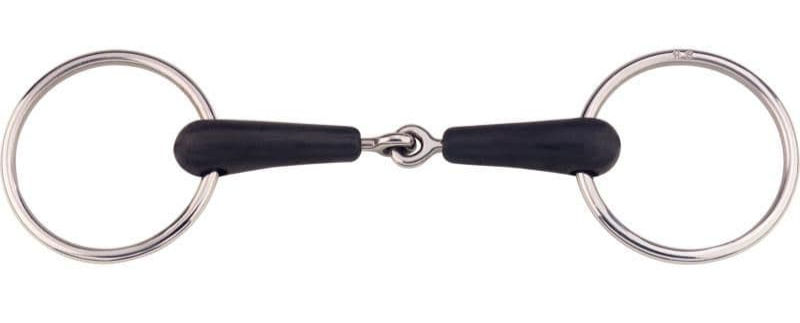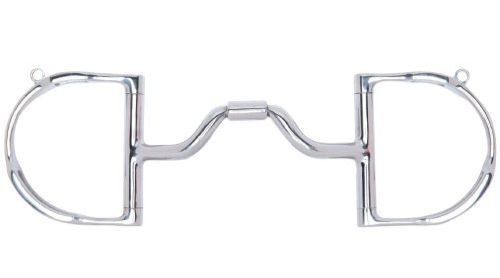Horse Bit Mouthpiece Types Explained
- Grab the Reins Equestrian

- Jan 9
- 4 min read
Updated: Jan 28
As well as our previous article about types of bit cheekpieces which you can read by clicking here, we also are going to discuss mouthpieces and bit materials.
Disclaimer
Whenever changing any of your horses tack, it is important to ask an equine professional or skilled trainer. Even the mildest of bits can be damaging to your horse due to incorrect fitting or incorrect use.
You can use the below menu to navigate if you would like to learn about a specific mouthpiece.
Materials
The material of a bit can be as important as the mouthpiece itself. Bits are most commonly made of stainless steel which is either solid or hollow, as it is strong and non rusting. However, there are other types that we will explore below.
Copper / Brass Alloy

Copper bits are used to encourage salivation and warm up quickly in the horses mouth. This can be useful for horses that do not enjoy the cold feeling in their mouth or those who do not engage with the bit. This is the same for brass alloy bits but the brass alloy does not rust and corrode like copper or sweet iron.
Sweet Iron

Sweet iron is just what it says, iron that is sweet. This heats up quicker than stainless steel, like copper, but its main use it to engage the horse with the bit. The more the bit is used and oxidises, the sweeter it tastes. It’s important to note that softer bits such as this need replacing more often.
Rubber


Rubber bits come in two types; rubber covered steel and full rubber. Full rubber bits are great for sensitive horses or youngsters due to its flexibility and softness, but needs to be checked regularly for tears and chew marks. Rubber covered steel is better for horses with a smaller mouth as it’s not as thick as pure rubber, but you still get the positives such as softness and flexibility.
Leather

Leather bits are uncommon but serve a use similar to warming bits like copper and sweet iron. Leather bits can be steel coated or full leather. Leather bits encourage salivation and the more a horse uses the leather bit, the more it conforms to their mouth shape as the leather softens.
Happy Mouth / Polymer

Happy Mouth bits are popular with young horses or particularly sensitive ones due to its flexibility and lack of coldness. Most Happy Mouth bits are apple flavoured which encourages salivation and makes learning aids enjoyable for young horses.
Mouthpieces
Single Jointed


Single jointed bits are compromised of two metal pieces, connected through two rings that form a V-shape in the horses mouth when pressure is applied. Single jointed bits put pressure on the edge of the tongue and lower jaw and are useful due to do riders being able to put pressure on one side of the mouth at a time.
Single jointed bits have become less popular in recent times due to the ‘Nutcracker’ effect. This happens when the bit forms a V-shape in the mouth. Horses with a flat or low palette may find discomfort in this as it will poke the roof of the mouth.
It is also common with single jointed bits to have on side longer than the other, it’s therefore important to switch your bit around regularly to keep equal balance of pressure.
French Link

A French link is comprised of two bars, separated by a small flat plate that puts pressure on the tongue and lips. This allows it to collapse without making a V-shape, reducing the nutcracker effect.
Dr. Bristol

Dr. Bristol mouthpieces are the same as a French link. However, the plate turns when the reins are engaged and becomes vertical instead of horizontal. This makes the bit stronger due to the smaller surface area of pressure.
Lozenge / Peanut

This mouthpiece is similar to the French link but instead of a plate, has an oval shaped lozenge in between its bars. A lozenge works the same as a plate but puts less pressure on the tongue due to its surface area.
Roller Link / Full Roller

A roller provides a horse something to play with and focus on, this engages the horse with the bit more and encourages salivation. The bit can have a roller link, like a French link but with a roller, or the entire bar can be a straight roller.
Waterford

A Waterford mouthpiece is compromised of many spherical links. This results in an equal pressure due to its flexibility which allows it to mould to the horses mouth. This makes the but difficult to lean on and encourages a steady contact.
It’s important to note that a Waterford requires an experienced rider with steady hands as any horizontal movement or sliding of the bit can cause discomfort and pinching.
Mullen


A Mullen mouthpiece is effectively a singular bar. Mullen mouthpieces can be straight, curved to accommodate the tongue or ported. Having a port means the bar has a section that sticks out, either up or
down.
A straight Mullen is the most gentle as it puts pressure on the tongue and not the sides of the mouth but is not good for leaning.
A bottom port puts more pressure on the tongue for horses that carry their head to high and a top port puts pressure on the palette, lifting a horse’s head upwards.
Keys

Keys refer to a mouthpiece that consists of dangly metal coming off the mouthpiece, shaped like keys on a keychain. This suits a young horse very early in its training or an extremely fussy horse that does not engage with the bit.
To find out about bit cheekpieces you can click here
Whenever changing any of your horses tack, it is important to ask an equine professional or skilled trainer. Even the mildest of bits can be damaging to your horse due to incorrect fitting or incorrect use.

Comments